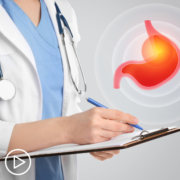What Are Key Risk Factors for Stomach Cancer?
What Are Key Risk Factors for Stomach Cancer? from Patient Empowerment Network on Vimeo.
What factors have strong links to stomach cancer? Expert Dr. Joo Ha Hwang from Stanford Medicine discusses key factors linked to diet, certain population groups, and proactive patient advice to reduce stomach cancer risk.
[ACT]IVATION TIP
“…if you do come from Asia, one, try and minimize the salt in your diet if at all possible, try not to add any additional salts, and try and stick to a lower sodium diet, lower sodium content diet, and then number two, get tested for H. pylori. I think that H. pylori really is the main driver, and we do see a declining incidence of gastric cancer in Asia and that’s largely attributed to better recognition of H. pylori and treatment of H. pylori.”
See More from [ACT]IVATED Gastric Cancer
Related Resources:

|

Can Stomach Cancer Risk Be Reduced by Treatment and Lifestyle Changes? |

What Stomach Cancer Care Obstacles Do Asian and Latinx Patients Face? |
Transcript:
Lisa Hatfield:
Dr. Hwang, are there any specific risk factors for gastric cancer that are more prevalent in Asian communities compared to other ethnic groups? Are there any hereditary factors?
Dr. Joo Ha Hwang:
I think the biggest risk factor that’s prevalent in Asian communities and also prevalent in wherever you see high incidence of gastric cancer, really the number one risk factor is H. pylori infection. So Helicobacter pylori infection, which is a bacterial infection of the stomach that’s usually obtained at a very young age, and basically persists in the stomach over decades and over decades someone can develop chronic inflammation that then changes the lining of the stomach to something called atrophic gastritis and gastric intestinal metaplasia.
And these are the precursors, or this is the pathway that many gastric, not all gastric cancers, but many gastric cancers take in their development. The other thing about Asian communities compared to other communities would be environmental things such as diet. So, I would say the Asian diet is probably saltier. There’s a higher salt content in the Asian diet than maybe the Western diet. And there was a recent study that showed that increased salt intake does affect your risk of developing gastric cancer. And we’ve actually known this for many, many years. Gastric cancer used to be one of the top three cancers in the United States and Europe back in the early 1900s. And I don’t think a lot of people know that.
And the two reasons that it’s gone down and the number one reason being refrigeration, so prior to refrigeration in order to preserve foods we salted everything. So there was an enormous salt content in our foods and you see, especially in Scandinavia, and you see a lot of the original gastric cancer research coming out of Scandinavian journals, and that just had to do with the fact that there was a lot of gastric cancer back then and so I think the rapid decline in the Western world can largely be attributed to both refrigeration and lower salt content and also the decreasing prevalence or the type of H. pylori that exists in the West.
And so I think that those are kind of the two primary risk factors that might be different in Asian communities versus the rest of the world. And so, my activation tip for this is if you do come from Asia, one, try and minimize the salt in your diet if at all possible, try not to add any additional salts, and try and stick to a lower sodium diet, lower sodium content diet, and then number two, get tested for H. pylori. I think that H. pylori really is the main driver, and we do see a declining incidence of gastric cancer in Asia and that’s largely attributed to better recognition of H. pylori and treatment of H. pylori.






